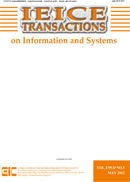E104.D 巻, 3 号
選択された号の論文の18件中1~18を表示しています
- |<
- <
- 1
- >
- >|
Special Section on Foundations of Computer Science — New Trends of Theory of Computation and Algorithm —
-
2021 年 E104.D 巻 3 号 p. 354
発行日: 2021/03/01
公開日: 2021/03/01
PDF形式でダウンロード (125K) -
原稿種別: PAPER
2021 年 E104.D 巻 3 号 p. 355-361
発行日: 2021/03/01
公開日: 2021/03/01
PDF形式でダウンロード (1577K) -
原稿種別: PAPER
2021 年 E104.D 巻 3 号 p. 362-369
発行日: 2021/03/01
公開日: 2021/03/01
PDF形式でダウンロード (468K) -
原稿種別: PAPER
2021 年 E104.D 巻 3 号 p. 370-380
発行日: 2021/03/01
公開日: 2021/03/01
PDF形式でダウンロード (313K) -
原稿種別: PAPER
2021 年 E104.D 巻 3 号 p. 381-388
発行日: 2021/03/01
公開日: 2021/03/01
PDF形式でダウンロード (293K) -
原稿種別: LETTER
2021 年 E104.D 巻 3 号 p. 389-391
発行日: 2021/03/01
公開日: 2021/03/01
PDF形式でダウンロード (69K) -
原稿種別: LETTER
2021 年 E104.D 巻 3 号 p. 392-393
発行日: 2021/03/01
公開日: 2021/03/01
PDF形式でダウンロード (54K)
Regular Section
-
原稿種別: PAPER
専門分野: Computer System
2021 年 E104.D 巻 3 号 p. 394-403
発行日: 2021/03/01
公開日: 2021/03/01
PDF形式でダウンロード (2893K) -
原稿種別: PAPER
専門分野: Software System
2021 年 E104.D 巻 3 号 p. 404-418
発行日: 2021/03/01
公開日: 2021/03/01
PDF形式でダウンロード (935K) -
原稿種別: PAPER
専門分野: Artificial Intelligence, Data Mining
2021 年 E104.D 巻 3 号 p. 419-429
発行日: 2021/03/01
公開日: 2021/03/01
PDF形式でダウンロード (1951K) -
原稿種別: PAPER
専門分野: Educational Technology
2021 年 E104.D 巻 3 号 p. 430-440
発行日: 2021/03/01
公開日: 2021/03/01
PDF形式でダウンロード (706K) -
原稿種別: PAPER
専門分野: Speech and Hearing
2021 年 E104.D 巻 3 号 p. 441-449
発行日: 2021/03/01
公開日: 2021/03/01
PDF形式でダウンロード (679K) -
原稿種別: PAPER
専門分野: Image Processing and Video Processing
2021 年 E104.D 巻 3 号 p. 450-460
発行日: 2021/03/01
公開日: 2021/03/01
PDF形式でダウンロード (4335K) -
原稿種別: LETTER
専門分野: Fundamentals of Information Systems
2021 年 E104.D 巻 3 号 p. 461-464
発行日: 2021/03/01
公開日: 2021/03/01
PDF形式でダウンロード (526K) -
原稿種別: LETTER
専門分野: Software System
2021 年 E104.D 巻 3 号 p. 465-468
発行日: 2021/03/01
公開日: 2021/03/01
PDF形式でダウンロード (686K) -
原稿種別: LETTER
専門分野: Information Network
2021 年 E104.D 巻 3 号 p. 469-472
発行日: 2021/03/01
公開日: 2021/03/01
PDF形式でダウンロード (295K) -
原稿種別: LETTER
専門分野: Pattern Recognition
2021 年 E104.D 巻 3 号 p. 473-476
発行日: 2021/03/01
公開日: 2021/03/01
PDF形式でダウンロード (1243K) -
原稿種別: LETTER
専門分野: Image Processing and Video Processing
2021 年 E104.D 巻 3 号 p. 477-480
発行日: 2021/03/01
公開日: 2021/03/01
PDF形式でダウンロード (2157K)
- |<
- <
- 1
- >
- >|
